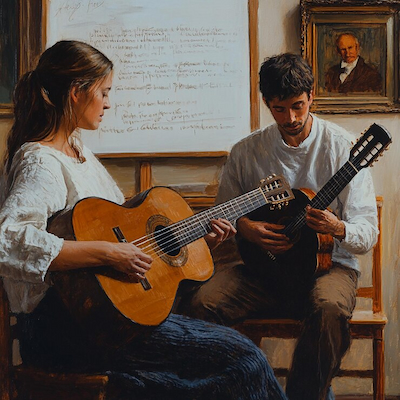
The guitar is one of the most versatile and beloved instruments in the world, with a rich history that spans centuries and cultures. Its presence in both classical and popular music reveals how a single instrument can adapt to multiple roles—ranging from refined concert performance to spontaneous musical expression in everyday life.
The classical guitar embodies precision, complexity, and artistic depth, while the popular guitar reflects emotion, accessibility, and cultural connection. This article explores how the guitar functions within these two distinct but interconnected traditions, the value of understanding its evolution, and how it continues to shape music across genres.

How Different Guitar Styles Work in Classical Music and Popular Traditions
Guitar styles in classical and popular music are diverse and culturally rich, reflecting the historical evolution of each tradition. In classical music, the guitar is often used as a solo instrument or in ensemble settings, offering a wide range of expressive possibilities. Classical composers like Francisco Tárrega and Andrés Segovia explored the guitar’s full capabilities, creating works that have become foundational pieces in the classical repertoire. Fingerpicking technique, complex chord progressions, and expressive interpretation are key features of classical guitar playing.
In popular traditions, the guitar plays an equally important role, but with a more accessible and varied approach. Styles such as samba, bossa nova, and rock incorporate the guitar in unique ways, adapting techniques and sounds to suit popular culture. Popular guitar playing often relies on simpler chords and rhythmic patterns, making it ideal for street music, social gatherings, and celebrations. This versatility allows the guitar to connect with diverse audiences, bridging the gap between sophistication and accessibility.
Moreover, the techniques and performance styles differ significantly across traditions. In classical music, emphasis is placed on technical precision and musical interpretation, whereas in popular music, emotional expression and improvisation are often prioritized. This duality enriches the broader musical landscape, allowing the guitar to evolve and adapt over time. Understanding this dialogue between classical and popular traditions is essential to grasp the full scope of the guitar’s musical influence.
Advantages of Understanding the History of the Guitar in Classical and Popular Traditions
Understanding the history of the guitar in both classical and popular traditions offers many advantages to musicians and music lovers alike. First, it allows for a deeper appreciation of musical works and styles. By learning about the guitar’s origins and evolution, listeners can connect emotionally with the music and recognize the influences and innovations that have shaped each tradition. This connection enhances the overall listening experience.
Additionally, historical knowledge provides valuable insight for musicians seeking to refine their skills. Studying the techniques and styles developed over time enables musicians to integrate both classical and popular elements into their own interpretations. This blending of traditions not only expands one’s repertoire but also fosters creativity and innovation, resulting in more dynamic and expressive performances.
Another important aspect is the cultural appreciation that comes from understanding the guitar’s history. The guitar reflects the traditions and cultural influences of different eras and regions. By studying this history, musicians and audiences become more aware of musical diversity and the contributions of various cultures to the guitar’s development. This promotes greater respect and appreciation for global music, encouraging cultural exchange and collaboration.
Finally, learning the history of the guitar allows both musicians and listeners to recognize its power as a tool for communication. The guitar has the ability to convey emotions, tell stories, and connect people. By exploring its evolution, musicians can use this expressive power more effectively, creating musical experiences that resonate with audiences and foster a sense of community.
How the Guitar Influences Classical and Popular Music
The guitar in classical music: an analysis of technique
Classical guitar playing is often defined by sophisticated techniques that require a high level of technical mastery. Classical works make use of various methods such as arpeggios, complex harmonies, and subtle dynamics, demanding a deep understanding of music theory from the performer. Regular practice and study of classical repertoire are essential for any guitarist seeking excellence in this genre.
The evolution of the guitar and its cultural influences
The evolution of the guitar over the centuries reflects broader cultural and social changes. From its origins in the Middle Ages to modern-day innovations, the guitar has undergone significant transformations influenced by musical styles, construction methods, and societal shifts. This evolution makes the guitar a dynamic, adaptable instrument suited to a wide variety of musical settings.
Famous guitarists and their contributions
Renowned guitarists have played a crucial role in popularizing and developing the guitar across genres. Figures such as Andrés Segovia, Heitor Villa-Lobos, and Paco de Lucía are just a few of the many artists who have left a lasting legacy. Their contributions have not only enriched the guitar repertoire but also inspired generations of musicians to explore new sonic and technical possibilities.
Musical styles and the guitar: a deep connection
The relationship between musical styles and the guitar is deep and multifaceted. The guitar is a highly versatile instrument found in genres ranging from classical to rock, including jazz, folk, and more. Each style brings its own characteristics and techniques, allowing the guitar to evolve while reflecting the nuances of each musical genre.
Classical guitar: characteristics and significance
Classical guitar is one of the most respected and admired styles in the art music world. With features like nylon strings and specific construction, the classical guitar produces a rich and nuanced sound. Its significance lies not only in its tonal beauty but also in its capacity to convey profound emotions, making it a cornerstone of classical music.
The popular tradition of the guitar and its social impact
The popular tradition of the guitar has had significant social impact, serving as a medium for cultural expression and identity. The guitar is often associated with festivities, gatherings, and collective experiences. Its presence across cultures shows the guitar’s ability to transcend barriers and connect communities, becoming a symbol of creativity, expression, and resilience.

Did You Enjoy Learning About the History of the Guitar in Classical Music and Popular Traditions?
Exploring the history of the guitar in classical and popular traditions is a fascinating journey that reveals the instrument’s richness and diversity. From its origins to its contemporary innovations, the guitar remains a powerful tool for artistic expression and communication. By learning about this history, you open the door to a world of musical possibilities.
We hope this article has sparked your interest in the story of the guitar and its many expressions in classical and popular music. Keep exploring, listening, and playing—because the guitar is an instrument that always has something new to teach and share.
Frequently Asked Questions
What is the origin of the guitar?
The guitar evolved from ancient string instruments. It developed from lutes and other early chordophones.
How did the guitar develop in classical music?
The guitar gained prominence in classical music during the 18th century. Famous composers began writing specifically for the instrument.
Is the guitar popular in traditional Brazilian music?
Yes, the guitar is very popular in Brazil. It is essential in genres like samba and bossa nova.
Are there differences between classical and popular guitar playing?
Yes, techniques and styles differ. Classical guitar emphasizes technical precision, while popular guitar focuses more on emotional expression.
How can I learn more about the history of the guitar in classical and popular music?
You can read books, watch documentaries, or take online classes. Explore, learn, and connect with fellow musicians!

